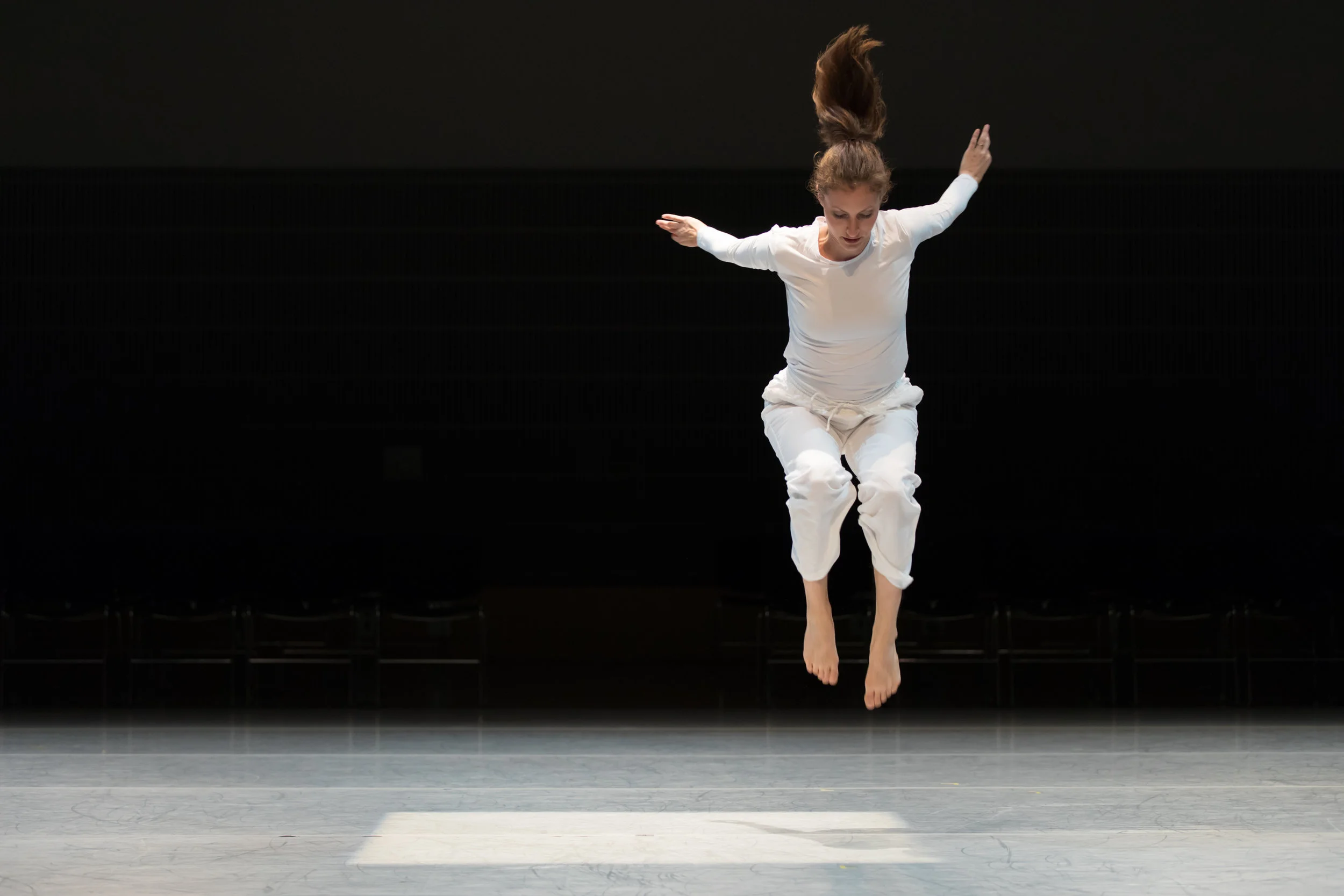by Emily Hoffman
Dancer Sarah Chenoweth performs Trisha Brown's Locus Solo (1975) as part of HMD's 2016 Bridge Project, Ten Artists Respond to Locus. Photo by Margo Moritz.
The most pronounced difference to my eye between Trisha Brown's movement and modern or balletic forms of movement is timing, or, more specifically, the more subtle variations in timing that are allowed or produced by the availability of the body to its own weight and to gravity. I first noticed this phenomenon in X when we were teenagers and it took me a long time—until now, really—to realize what was producing it, but I did for many years find different ways of describing to myself what it looked like. I noticed it most clearly, of course, when she was dancing in unison with other people who didn’t share this same quality. Say there was a simple drop and lift of the arm—from horizontal, to vertical, to horizontal again. You’d see the arms start to come down, and it would seem X was somehow behind the count. You could feel the unit of time and see how the other arms were going to make it back, and X’s arm seemed leisurely by comparison, unconcerned. Then a surprising thing would happen. The count would arrive and suddenly there her arm was, floating into horizontal, more subtly on it than anyone else’s. But she hadn’t sped up—that was the magic of it. I used to say it was like her blood was made of time, that’s how dexterous she was with it; it seemed she could move time, making it expand or contract. The even arcs of the other arms seemed crass by comparison. It occurs to me now that what I was seeing was the subtle, organic ease and variation that comes from the play between a release into weight and a more muscular resistance to gravity. I suppose you could also call this phrasing, in another kind of dancing, and a dancer can have a gift with time separate from this particular released weight that I’m referring to. It’s what they call musicality, I think, in ballet. But perhaps it amounts to the same thing. How the dancer relates to control and release in her own body, a relation to momentum, to gravity, and to resistance. Choreography will always specify a point A and a point B, and even if these points become closer and closer together, there will always be some distance between them that the dancer must traverse in her own manner. I have a weakness for projecting aesthetics into the realm of the ethical, but it’s hard for me not to feel that something about the character of the dancer is revealed in exactly this, the body’s native relation to the structure it occupies. Whether it rushes to fulfill the structure, whether it adorns it, whether it holds itself in reserve. Why is it always that reserve and abandon seem to go hand in hand? I’m always drawn to describe Farrell’s dancing with this kind of paradox. Precisely to the extent that she gives herself to the movement her SELF is revealed to be a separate entity, out of reach. This is absolutely different from a coy restraint. By contrast, it is the absolute absorption of the dancer in the execution of the dance that gives the dancer back to herself. I see this as a kind of grace in effort, otherwise known as devotion.
--
Emily Hoffman is the Director of Affinity Project, one of ten artists commissioned to create new work in response to Trisha Brown's Locus (1975), as part of Hope Mohr Dance's 2016 Bridge Project, Ten Artists Respond to Locus, produced in association with Yerba Buena Center for the Arts. This post is one in a series that will feature ephemera from the Locus Bridge Project.
Affinity Project performing Color grid with talking (after Locus), part of "Ten Artists Respond to Locus." Featured performers (L to R): Nora el Samahy, Atossa Babaoff, Bea Basso. Photo by Margo Moritz.


